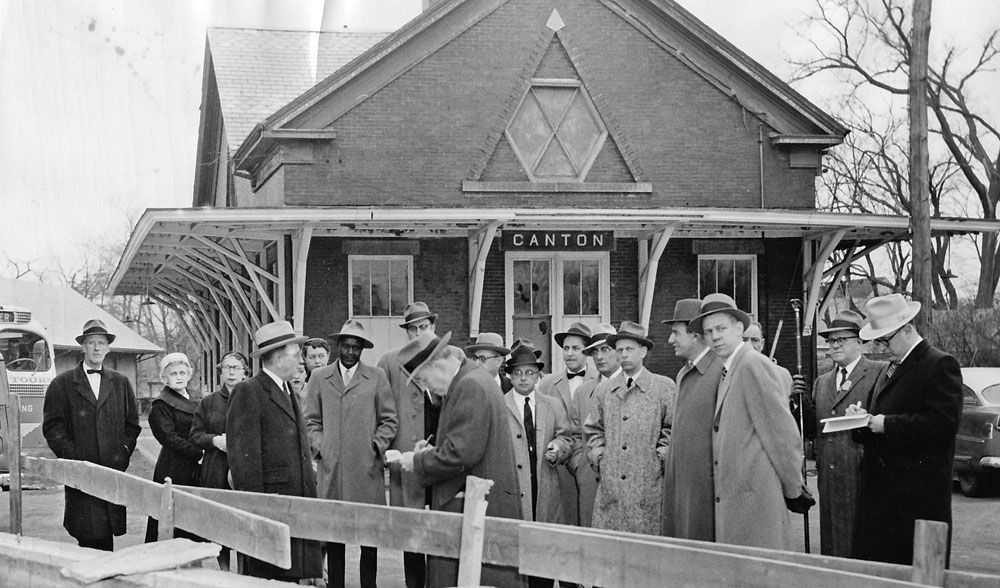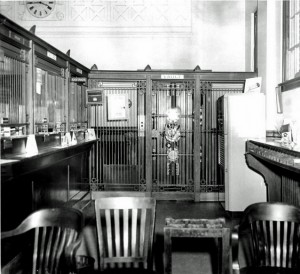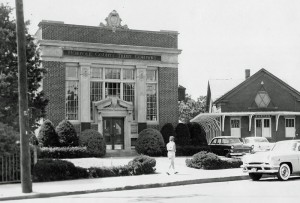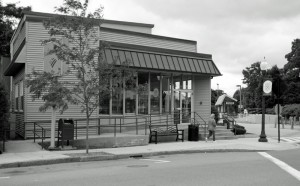True Tales: The Great Bank Robbery Part 2
By George T. Comeau
The jury at the scene of the holdup at the Norfolk County Trust, January 7, 1958 (Courtesy of the author)
Editor’s note: Below is the second in a two-part series about the robbery of the Norfolk County Trust Company in Canton on July 18, 1957. Part 1 of the series appeared in the Citizen on May 24.
As 21 patrons were herded into the vault at the Norfolk County Trust Company, many of them wondered if the tiny space would become their tomb. Stacked back to back, the room barely contained all the people. Ethel Milligan immediately felt safe.
“Everybody was so quiet,” she said. “I was the last one in … and I figured I was safe because I was now in the vault.”
Safe, mainly due to the fact that she was on the inside and the three criminals were outside heading down the stairs and into their waiting getaway car. Nevertheless, she said recently, “We thought we were dead.”
The bank robbers ran past Rachel Estey, who was waiting for her cousin Judy. Just minutes before, Judy (Shaw) Walker had been standing in line to cash her paycheck. The 24-year-old nursing student, a lifelong resident of Canton, was concerned that her meager overtime check might become part of the robber’s proceeds. As she was ordered into the vault, she thought, “It will all be okay. The police will be along soon.”
Domenic Staula was also stuffed into the small space. “They closed the door, but there was a threshold that had to be folded up, and they jammed the door so it never closed tightly,” he said.
Milligan recalls a small switch that started a ventilating fan that brought fresh air into the space. “It was the size of a small water pipe,” she said, “and I knew it would not bring in much air.” The temperature began to rise rapidly.
This was a vault door that operated on a timer. Milligan can still remember the door closing, and to her relief the door seemed to have caught on something. Milligan, a seasoned bank teller, explained: “At the end of the day you would wind the spring to the door and the lock would time to open the next day. There is no way to open the door until the clock wound down.” Someone inside the vault threw an alarm switch hoping to attract attention.
Staula knew what had happened when the door was closed. “As you walked into the vault there was a little ramp, and it had to be folded up in order to close the door,” he said. “In their haste, the robbers failed to notice the threshold and the door never really closed completely.”

The interior of the bank and the vault where 21 people were locked away after the bank heist (Courtesy of the author)
The robbery was so well timed that as the three robbers fled the scene, they headed north up Washington Street across the tracks at Canton Center, just as the flashing gate dropped to stop traffic. The Budd Liner, a diesel commuter train, approached the station. As the getaway car fled the scene, the gates dropped and the warning bells masked the alarm bells of the vault.
Inside the vault the captives stayed calm awaiting rescue — surely someone would hear the alarm and help would arrive. Indeed, help came at the hands of two patrons entering the now empty bank. Pharmacist James Dykeman and Benny Carroccio of Canton Lumber and Supply Company entered the bank and saw the open drawers. The scene must have stunned the men.
Accounts differ as to what happened next. Staula recalls that the “vault opened … Jimmy Dykeman opened the door and he stood there — it was like opening a sardine can — and he stood there staring with his mouth opened … just taking it in … dumbstruck.” As Dykeman backed away from the vault, “Fitzie the cop” yelled out, “Call the cops.” The two amazed men ran across the street to summon Sergeant Ruane, and as the train passed, the alarm from the vault was heard ringing through the downtown morning air.
Newspapers reported that it was Ruane who had opened the vault door, and he quickly summoned acting chief Joseph Buckley. The chief of police, Joseph Galligan, was on vacation when the robbery occurred. And in those days the police station was located on Revere Street. Buckley thought that the bank alarm was just another false alarm as had occurred a week before and started to walk up Washington Street as there was no car available at the time.
Within minutes the local police knew that this was a major crime. An all-points bulletin was ordered in search of the two-tone green and cream 1956 Oldsmobile 88. The car, along with several sets of stolen registration plates, was found the next day abandoned on Route 135 in Dedham.
The Norfolk County Trust Company was a federally insured bank, and the Federal Bureau of Investigation sent field officers to the scene. More than $30,000 was stolen, and while it is hard to believe today, this was one of the largest bank heists of its day. By late morning the “feds” had arrived to interview the witnesses. Not all the witnesses were immediately available. When Judy Shaw had been sprung from the vault, she and her cousin went shopping for the day. Arriving home at 5 p.m., her mom was waiting, along with two federal agents in the living room.
In particular, Milligan and Staula, both from Canton, would play pivotal roles in the search and conviction of the three bank robbers. It took less than two months to track down the criminals. The FBI had several good leads to go on, which led them to Arnold and Alvin Campbell. Canton residents closely followed the bank heist; after all, it was their neighbors that had been placed in the face of death by the reckless Campbells.
On September 12, the Canton Journal blazed a headline: “FBI nabs bank robbery suspect at Roxbury home.” Alvin Campbell was the first to be charged with the hold-up of Norfolk Country Trust Company. He was arraigned before U.S. Commissioner Peter J. Nelligan on a charge of armed robbery and ordered held on $50,000 bail. Authorities knew they had their man — upon being charged with the crime of bank robbery, Campbell asked to contact attorney Lawrence O’Donnell of the Brinks Trial fame. O’Donnell was one of the sharpest criminal defense attorneys of his day, and the Campbells were assured of an advantage in the trial system. Soon, both brothers were in custody, and by December the third perpetrator was under arrest.
Staula recalls that just leading up to the arrest he had been asked to drive with an FBI agent past Campbell’s place of work, a gas station, to do a drive-by identification. After the elder Campbell was arrested, many of the witnesses were brought into Boston to participate in a lineup.
Officer Fitzgerald said the suspect resembled the man who held him at gunpoint, but it was Milligan who made the positive identification. “I was scared to death when I identified them … on a stage … they could see me and touch me,” she said. “I picked them right out.” To protect the witnesses, each time they were brought to court, a police escort accompanied them into Boston.
On December 17 the trio was indicted by a grand jury, and by February the trial was underway in the court of Federal Judge William T. McCarthy. The trial was quick, and Milligan, Staula and Shaw were there, along with dozens of other witnesses. Just like in the movies, there was plenty of courtroom drama. The Canton witnesses played their parts perfectly and stood up against a blistering defense. At one point, Attorney O’Donnell asked to see the notes from Staula’s interview with the FBI.
On the day after the robbery, Staula had sat alone in a room at the Canton Police Station, where he was interviewed by Agent Toomey. The notes taken on that day would forever change the legal system and the rules of evidence. At the trial, in order to impeach Staula, the defense asked for the FBI to produce the notes. The prosecution refused, and the judge decided not to make the notes available. In fact, the judge was pretty crusty and knew a criminal when he saw one — or three in this case. There was no need for a fair and balanced trial here; these were guilty men.
The three bank robbers were found guilty, and the sentence was pronounced from the bench. The men were each given 20 years for armed robbery, 10 years for larceny, 25 years on each of five other complaints of aggravated robbery and putting persons in fear of bodily harm.
The judge exclaimed that this trio has “no chance of rehabilitation.” “Society will be better off with men of this type behind bars,” he said. In the end, the sentences added up to over 155 years each.
These men were destined to spend the rest of their natural lives behind bars. But soon after the convictions, appeals began, and they were largely centered on the fact that they were denied a fair trial when the FBI refused to turn over their notes from the Staula interview. An appeal to the U.S. District Court in Boston failed to yield a release, and the case would have ended there, but for the tenacious O’Donnell.
O’Donnell appealed to the United States Supreme Court. On December 6, 1960, three years after the crime was committed, the highest court in the land sent down a decision that reversed the lower courts’ findings. The perpetrators were set free on a matter of law — that being the fact that they were not in a position to fairly defend themselves when the FBI failed to turn over the agent’s notes from Staula’s interview.
True to the original assessment of the judge that convicted them, these men went on to commit several more crimes. Associated with the Winter Hill Gang, Alvin Campbell served time in Leavenworth Prison along with Whitey Bulger. Over the course of his criminal career he was charged with a triple murder in 1968 in which he escaped conviction after Johnny Martorano allegedly murdered the main witness to the heinous crime. Arnold Campbell retired and lives with his daughter in Arizona.
Short URL: https://www.thecantoncitizen.com/?p=14129












